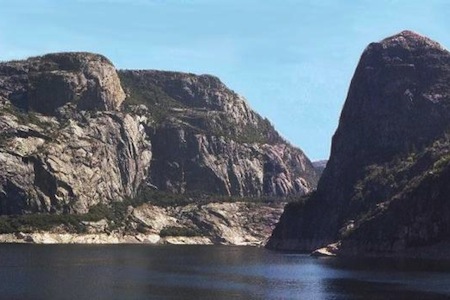Hetch Hetchy Redux: An Effort to Turn Back the Environmental Clock

The flooded Hetch Hetchy Valley. Credit: Wikimedia Commons.
 If San Francisco voters pass Measure F on November 6, the city will conduct an $8 million study on the feasibility, costs, and benefits of draining the 300-foot deep reservoir created by the O’Shaughnessy Dam in 1923. The measure’s proponents see it as a first step in restoring Hetch Hetchy Valley, sister valley to Yosemite, to its natural state. That the measure is even on the ballot is a significant indication of the shift in attitudes towards the ongoing conflict between nature preservation and traditional notions of progress.
If San Francisco voters pass Measure F on November 6, the city will conduct an $8 million study on the feasibility, costs, and benefits of draining the 300-foot deep reservoir created by the O’Shaughnessy Dam in 1923. The measure’s proponents see it as a first step in restoring Hetch Hetchy Valley, sister valley to Yosemite, to its natural state. That the measure is even on the ballot is a significant indication of the shift in attitudes towards the ongoing conflict between nature preservation and traditional notions of progress.
Those who opposed the original damming of Hetch Hetchy a century ago were primarily women who believed that the beauty of the valley was more valuable than the water its damming would redistribute, but nature lovers of both sexes were accused of being weak and sentimental. Pioneering educator and psychologist G. Stanley Hall claimed that preservationists suffered from “effeminization” and charged that “caring for nature was female sentiment, not sound science.”
Journalist George L. Knapp expressed the prevailing view when he termed all calls for nature preservation “unadulterated humbug” and the dire prophecies concerning the destruction of nature “baseless vaporings.” He preferred to celebrate the fruits of men’s unregulated resource manipulation and consumption: “The pine woods of Michigan have vanished to make the homes of Kansas; the coal and iron which we have failed -- thank Heaven! -- to ‘conserve’ have carried meat and wheat to the hungry hives of men and gladdened life with an abundance which no previous age could know.” According to Knapp, men should be praised, not chastened, for turning “forests into villages, mines into ships and skyscrapers, scenery into work.”
Some men risked being scorned for holding “unmanly” views in their efforts to save the valley. Wilderness preservation icon and Sierra Club founder John Muir was a prime target, rendered both impotent and feminine in a contemporary cartoon that depicts him, elaborately clothed in a dress, apron, and flowered bonnet, fussily (and fruitlessly) attempting to sweep back the waters flooding Hetch Hetchy Valley. By 1910, Muir’s crusade to preserve the glories of the valley in its natural state rather than inundate it to accommodate San Francisco’s need for water was supported by 150 women’s clubs nationwide.
Muir and his fellow preservationists were opposed, however, by Gifford Pinchot. Although Pinchot, who was serving as the first chief of the Forestry Service, was a self-avowed conservationist, he escaped the charges of effeminacy heaped on Muir by making it clear that he measured nature’s value by its service to humanity. “Wilderness is waste,” he famously proclaimed. “Trees are a crop, just like corn.” He dedicated his agency to “the art of producing from the forest whatever it can yield for the service of man.”
When the U.S. House Committee on Public Lands debated the flooding of Hetch Hetchy, Pinchot’s testimony, that use should take precedence over beauty, was echoed by former San Francisco mayor James Phelan. He attacked Muir, arguing, “To provide for the little children, men and women of the 800,000 population who swarm the shores of San Francisco Bay is matter of much greater importance than encouraging a few who, in solitary loneliness, will sit on the peak of the Sierras loafing around the throne of the God of nature and singing His praise.” San Francisco’s city engineer, Marsden Manson, spoke for many when he described Hetch Hetchy’s defenders in thinly-veiled homophobic terms as “short haired women and long-haired men.”
The view that flooding Hetch Hetchy Valley was the necessary and right step towards progress clearly won the day, and today the reservoir holds water that finds its way to some 2.5 million Bay Area residents. Yet scientists who have studied the area for years agree that, with proper management, the valley could be restored to its former grandeur in fifty to a hundred years.
Defenders of the status quo, including Senator Dianne Feinstein and San Francisco Mayor Ed Lee, assert that to attempt to turn back the clock would cost billions and deprive the region of a reliable water source. Proponents of restoration point out that, as a reservoir, Hetch Hetchy produces no water, but serves only as a storage facility. They promote water conservation and recycling, and propose storing the area’s water in nearby reservoirs. Moreover, they note that the beauty of the valley in its original state is beyond price, and urge than a major environmental wrong be righted.
Many San Franciscans pride themselves on their environmentalism, yet live in a city whose entire water supply is contained in a dammed up valley of once-great natural beauty. Regardless of Measure F’s outcome, its presence on the ballot signifies the growing reach of the environmental movement. It also indicates an increasing questioning of the prevailing arguments of a century ago -- that it is a sign of unadulterated progress when nature protection is sacrificed to ensure urban growth.
